We've independently reviewed this article to make sure it's as accurate as we can make it.
To find out more about our article creation and review process, check out our editorial guidelines.
Most people don’t think about their HVAC system… until they have to fix it or replace it.
Since these units can last even 20 years when well maintained, the market can change a lot by the time we get back to it. Brands can appear, vanish, merge, or split. Sometimes two can even seem to be the same thing—or vice versa!
Anyone looking at the market today will see both Ruud and Rheem products on sale. Sometimes it seems like there’s no difference between them at all. So what gives? How are Ruud and Rheem different?
The HVAC industry, like most other industries, has merged so that there are fewer than a dozen major manufacturers. Rheem Manufacturing Company makes both Rheem and Ruud products. These are almost the same. The two brand names are both reliable, efficient, and committed to innovation.
If you want to understand these brands and get some tips on picking a good central air conditioner, read on!
A Family of Brands
Today, just a few large companies own most of the brands we come across.
The way that many brands get absorbed under parent companies is called consolidation. Proctor & Gamble owns four brands of competing dish soap. Disney owns the competing Star Wars franchise and the Marvel Cinematic Universe. Paloma industries owns the Rheem Manufacturing Company, and through it Ruud.
Just like Star Wars, though, Rheem built up its fame on its own before Paloma bought it. Ruud did the same before Rheem bought it. Both firms have histories of innovation and quality products. They were making a name for themselves long before even getting into air conditioning, much less joining under the same company.
Ruud’s History
Edwin Ruud was a Norwegian immigrant to America who developed the first automatic water heater. When he began making it in 1889, hot running water was almost unknown, even to the wealthy. This made him and his company incredibly successful.
It was another sixty years before the company began to develop heating and air conditioning appliances in the 1950s. By this point, the Ruud name was a trusted brand, and they made good products.
Rheem’s History
The Rheem Manufacturing Company began in 1925 in California. It was originally a manufacturer of steel drums, and produced lots of other types of products over the years. It wasn’t until the 1950s that they began to make HVAC appliances—at about the same time as Ruud!
Though Ruud was a competitor, Rheem was able to turn this to their advantage. When they bought out the company in 1960, they used Ruud’s Kalamazoo plant to produce all their heating products and air conditioners. This specialization was very profitable.
Paloma Steps In
In 1988, Paloma Industries, based in Nagoya, Japan, purchased the Rheem Manufacturing Company. Paloma is a producer of gas appliances, with subsidiary companies all over the world.
Even though it isn’t independent, Rheem continues to innovate and modernize. It is still an award winning leader in sustainability initiatives! The Ruud brand has also made these commitments, working to meet them by 2025.
You know how sometimes store brand foods are just the brand name in a different package? Ruud and Rheem air conditioners are so similar that which you get might just depend on which is closer. In response to being asked the difference between the brands, an HVAC enthusiast replied “about 8 miles.”
With so many brand names bundled up inside each other like a nesting doll, it can be difficult to understand what you’re really getting. Hopefully, this guide helped you understand the differences (and the big overlap) between the Ruud and Rheem names.
What to Look for in a Good Air Conditioner
Buying an air conditioner, whether it’s Ruud, Rheem, or one of their competitors, is an exciting opportunity, but a stressful one as well. After all, you’re looking to spend thousands of dollars on an appliance that might last decades. You want to make a good choice.
Thankfully, the market is full of good choices. Ruud, Rheem, Carrier, Goodman, Trane, York… you’ve got options. While there is no single best choice for everyone and no one-size-fits-all solution, there’s a few things you want to be sure of when making your pick:
- Get the right size: Maybe the most important thing to remember, air conditioners are made to cool specific sizes of rooms or houses. Both small units like window air conditioners and central air conditioners should be sized exactly to your needs.

- Consider inviting a professional: Sizing an AC isn’t only dependent on square footage. Features like high ceilings, lots of sunlight, or poor insulation can make a big change to your needs. Take a look at our window AC size calculator to get an idea. Because of this, professional assessment of your home can help you figure out what your real needs are.
- Shop around: Central air installation is a job for professionals. When looking for your contractor, get quotes from at least two or three local firms. Double check their ratings with the Better Business Bureau to be sure you know what you’re getting into.
- Pay attention to efficiency: Energy Star rated products estimate the cost of running your air conditioner. What you might not know is that the SEER2 rating is an even more important number! The lowest you should get now is a 14 on the SEER2 scale, but if you can hit 20, you’ve got a really efficient machine! This can save you serious money over the years. The average household spends half of its energy bill on temperature control!
Efficiency ratings used to be measured on a ‘SEER’ rating. As of Jan 1, 2023, The new Energy Code went into effect and the SEER rating is now called a SEER2. It is a more stringent test that measures the systems with ductwork or more static pressure. The old test was not a realistic scenerio, as it was tested without any ductwork.
- Quiet it down: While you won’t find many air conditioners that can honestly claim to be quiet, you don’t want a jet engine roar whenever you cool your home. Pay attention to the noise levels, especially for indoor or window units.
- Keep it accessible: Though you want your air conditioner to be out of the way, you’re going to want to get to it a few times a year, if only to change the filter. Make sure it isn’t trapped behind a woodpile or in a window you need a ladder to reach.
- Pick your bells and whistles: Do you want smart cooling programmable from your phone? A zone-cooling system relying on dampers? This is the best chance to get the features that make you most comfortable.

Both Rheem and Ruud suggest you work with a professional, and they’re right! Even after getting your new air conditioner, you should still talk to your contractor about long-term care. Most firms offer a maintenance plan, which can save you a lot of work.
More importantly, like most appliance (and human) health, an ounce of prevention is worth a pound of cure. It’s useful to have a professional on hand to catch problems before they have a chance to become serious. This can dramatically improve the lifespan and function of your AC (and save money)!
Conclusion
Even though there isn’t a much bigger difference between Ruud and Rheem than the name on the appliance, it really does matter what AC you get. This is an investment for the next 20 years. The level of comfort and the operating cost are both very important.
Make sure both the brand and your contractor are as well-reviewed, and double check to make sure you’re getting a system that fits your needs. With a little work, you’ll enjoy cool air for ages to come.
Thank you for reading this article! We hope you feel more confident as you navigate between Rheem, Ruud, and every other brand. For more on air conditioners, please consider reading our related articles below!







